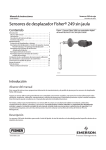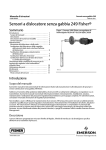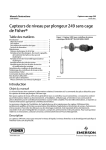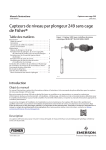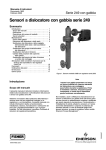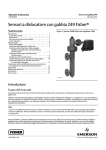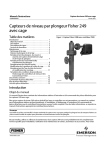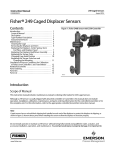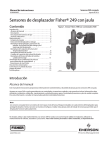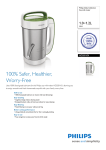Download Emerson 249P Instruction Manual
Transcript
Instruction Manual 249 Cageless Sensors D200100X012 December 2012 Fisherr 249 Cageless Displacer Sensors Contents Introduction . . . . . . . . . . . . . . . . . . . . . . . . . . . . . . . . . 1 Scope of Manual . . . . . . . . . . . . . . . . . . . . . . . . . . . . . 1 Description . . . . . . . . . . . . . . . . . . . . . . . . . . . . . . . . . 1 Type Number Description . . . . . . . . . . . . . . . . . . . . . 2 Educational Services . . . . . . . . . . . . . . . . . . . . . . . . . 3 Maintenance . . . . . . . . . . . . . . . . . . . . . . . . . . . . . . . . . 3 Removing the Displacer and Stem . . . . . . . . . . . . . . 4 Replacing the Displacer, Cotter Spring, Stem End Piece, and Displacer Spud . . . . . . . . . . 6 Replacing the Displacer Rod/Driver Assembly . . . . 7 Replacing the Torque Tube . . . . . . . . . . . . . . . . . . . . 8 Replacing the Torque Tube Arm and Changing the Mounting . . . . . . . . . . . . . . . . . . . . 9 Simulation of Process Conditions for Calibration of Fisher Level Controllers and Transmitters . . . . . . . . . . . . . . . . . . . . . . . . . . . . 10 Parts Ordering . . . . . . . . . . . . . . . . . . . . . . . . . . . . . . . 10 Parts Kits . . . . . . . . . . . . . . . . . . . . . . . . . . . . . . . . . . . 11 Parts List . . . . . . . . . . . . . . . . . . . . . . . . . . . . . . . . . . . 11 Sensor Common Parts . . . . . . . . . . . . . . . . . . . . . . . 11 Figure 1. Fisher 249V Sensor with FIELDVUE™ DLC3010/DLC3020f Digital Level Controller W3120‐3 Introduction Scope of Manual This instruction manual includes maintenance and parts ordering information for Fisher 249 cageless displacer sensors. Although a 249 sensor is usually shipped with attached controller or transmitter, this manual does not include operation, installation, calibration, maintenance, and parts ordering information for the controller/transmitter or for the complete unit. For this information, refer to the appropriate controller/ transmitter instruction manual. Do not install, operate, or maintain a 249 sensor without being fully trained and qualified in valve, actuator, and accessory installation, operation, and maintenance. To avoid personal injury or property damage, it is important to carefully read, understand, and follow all of the contents of this manual, including all safety cautions and warnings. If you have any questions about these instructions, contact your Emerson Process Management sales office. Description 249 sensors are designed to measure liquid level, interface level, or density/specific gravity inside a process vessel. www.Fisher.com Instruction Manual 249 Cageless Sensors D200100X012 December 2012 A torque tube assembly (figure 2) and displacer provide an indication of liquid level, interface level, or density/specific gravity. The torque tube assembly consists of a hollow torque tube with a shaft welded inside it at one end and protruding from it at the other end. Figure 2. Typical Side‐Mounted Cageless Displacer TRAVEL STOP ASSEMBLY W1800‐1 KNIFE EDGE BEARING DISPLACER ROD DISPLACER TORQUE TUBE W0172‐1 The unconnected end of the tube is sealed by a gasket and clamped rigidly to the torque tube arm, permitting the protruding end of the shaft to twist and therefore transmit rotary motion. This allows the interior of the torque tube to remain at atmospheric pressure, thus eliminating packing and the disadvantages of packing friction. The displacer always exerts a downward force on one end of the displacer rod. The other end of the displacer rod rests on the knife‐edge of the driver bearing. A keyed shaft on the bearing end of the displacer fits into a socket on the outside of the welded end of the of the torque tube assembly. A change in liquid level, interface level, or density/specific gravity buoys up the displacer by a force equal to the weight of the liquid displaced. Corresponding vertical movement of the displacer results in angular movement of the displacer rod around the knife edge. Since the torque tube assembly is a torsional spring which supports the displacer and determines the amount of movement of the displacer rod for a given displacement change, it will twist a specific amount for each increment of buoyancy change. This rotation is brought through the torque tube arm by the protruding rotary shaft. A controller or transmitter attached to the end of the rotary shaft converts the rotary motion into varying pneumatic or electric signals. Unless otherwise noted, all NACE references are to NACE MR0175-2002. Type Number Description D 249BP—CL150, 300, 600 steel top‐mounted sensor D 249CP—CL150, 300, 600 stainless steel top‐mounted sensor 2 Instruction Manual 249 Cageless Sensors D200100X012 December 2012 D 249P—CL150, 300, 600, 900 or 1500 steel top‐mounted sensor Note 249P CL150, 300, and 600 sensors are only available in Europe. D 249V—CL125 or 250 cast iron or CL150, 300, 600, 900, or 1500 steel side‐mounted sensor Note 249V sensors are only available in Europe. All cageless 249 sensors have flanged connections. The Parts List section shows some 249 sizes by construction, standard displacer lengths, and standard materials and table 1 contains displacer and torque tube materials. However, 249 parts are available in a wide variety of materials of construction, part dimensions, and other specifications. Contact your Emerson Process Management sales office for assistance in selection of specific materials, dimensions, and specifications. Table 1. Displacer and Torque Tube Materials Standard Material Other Materials Displacer Part 304 Stainless Steel 316 Stainless Steel, N10276, N04400, Plastic, and Special Alloys Displacer Stem, Driver Bearing, Displacer Rod and Driver 316 Stainless Steel N10276, N04400, other Austenitic Stainless Steels, and Special Alloys N05500(1) 316 Stainless Steel, N06600, N10276 Torque Tube 1. N05500 is not recommended for spring applications above 232_C (450_F). Contact your Emerson Process Management sales office or application engineer if temperatures exceeding this limit are required. Educational Services For information on available courses for 249 displacer sensors, as well as a variety of other products, contact: Emerson Process Management Educational Services, Registration P.O. Box 190; 301 S. 1st Ave. Marshalltown, IA 50158-2823 Phone: 800-338-8158 or Phone: 641-754-3771 FAX: 641-754-3431 e‐mail: [email protected] Maintenance Sensor parts are subject to normal wear and must be inspected regularly and replaced as necessary. The frequency of inspection and replacement depends upon the severity of service conditions. 3 249 Cageless Sensors December 2012 Instruction Manual D200100X012 WARNING Always wear protective clothing, gloves, and eyewear when performing any maintenance operations to avoid personal injury. Avoid personal injury or property damage resulting from the sudden release of pressure. Before performing any maintenance procedure: D Relieve any process pressure in the process vessel where the 249 sensor is installed. D Drain the process liquid from the process vessel. D Shut off any electrical or pneumatic input to the controller or transmitter attached to the 249 sensor and vent any pneumatic supply pressure. D Use caution when loosening flange bolting or pipe plugs (key 26). D Remove the controller or transmitter from the torque tube arm (key 3). Before performing any maintenance procedure requiring the handling of the displacer, inspect the displacer (key 10) to make sure process pressure or liquids have not penetrated the displacer. The displacer in this unit is a sealed container. If penetrated by process pressure or liquid, the displacer may hold pressure or hazardous liquid for an extended period. A displacer that has been penetrated by process pressure or liquid may contain: D pressure as a result of being in a pressurized vessel. D liquid that becomes pressurized due to a change in temperature. D liquid that is flammable, hazardous, or corrosive. Sudden release of pressure, contact with hazardous liquid, fire, or explosion, which might result in personal injury or property damage, can occur if a displacer that is retaining pressure or process liquid is punctured, subjected to heat, or repaired. Handle the displacer with care. Consider the characteristics of the specific process liquid in use. Check with your process or safety engineer for any additional measures that must be taken to protect against process media. Note Except for gaskets (keys 13, 14), trouble symptoms peculiar to specific parts are discussed in the following sections. Each section is specific to these parts. Regardless of location, gasket failure is indicated by leakage in the gasket area. Every time a gasket is removed, replace it with a new one upon reassembly. The procedures below apply to all sensor types except where indicated. Key numbers used are shown in the following illustrations: D 249BP—figure 5 D 249CP—figure 6 D 249P—figure 7 D 249V—figure 8 Removing the Displacer and Stem The displacer (key 10) is a sealed container. If the displacer has been penetrated by process pressure or liquid, it may hold pressure or hazardous liquid for an extended period. 4 Instruction Manual 249 Cageless Sensors D200100X012 December 2012 Process residue buildup on the displacer and stem (key 24) may change displacer weight or displacement. A bent stem or a dented or corroded displacer can impair performance. If the displacer rests against the travel stop, appears to be overweight, or causes output drift or other output inaccuracies, it may have been penetrated by process pressure or liquid. Such a displacer may contain pressure because it was in a pressurized vessel, may contain process liquid that becomes pressurized due to a change in temperature, and may contain process liquid that is flammable, hazardous, or corrosive. WARNING Sudden release of pressure, contact with hazardous liquid, fire, or explosion, which may result in personal injury or property damage, can occur if a displacer that is retaining pressure or process liquid is punctured, subjected to heat, or repaired. Handle the displacer with care. Note On the 249V, 249P, and 249BP with travel stop, the displacer must come out with the sensor head (key 2) or torque tube arm (key 3) before being completely disconnected from the displacer rod (key 7). If separating the displacer and displacer rod, remove the cotter spring (key 11). CAUTION Be careful not to let the displacer slip and drop into the bottom of the process vessel, as displacer damage could result. 1. Before starting any maintenance procedure, be sure the following safety actions are completed. D Relieve process pressure in the process vessel where the 249 sensor is installed. D Drain the process liquid from the process vessel. D Shut off any electrical or pneumatic input to the controller or transmitter attached to the 249 sensor and vent any pneumatic supply pressure. Remove the controller or transmitter from the torque tube arm. D Use caution when loosening flange bolting or pipe plugs. D Be sure process pressure or liquids have not penetrated the displacer. 2. Support the sensor head (key 2) and the torque tube arm (key 3). Remove the bolting that holds the sensor head to the process vessel. CAUTION When removing a sensor from a process vessel, the displacer may remain attached to the displacer rod and be lifted out with the sensor head (key 2) when the sensor head is removed. If separating the displacer and displacer rod before removing the sensor head, remove the cotter spring (key 11). If the displacer comes out with the head or torque tube arm, be careful not to damage the displacer or bend the stem when setting the head or arm down. 5 Instruction Manual 249 Cageless Sensors D200100X012 December 2012 Be careful not to let the displacer slip and drop into the bottom of the process vessel, as displacer damage could result. 3. Carefully remove the sensor head or torque tube arm. 4. On the 249V, the travel stop plate can be located in one of four positions as shown in figure 3. For proper operation in the target application, the displacer rod must not touch either plate over the expected range of process conditions. D When the displacer is completely submerged in the upper fluid, the net load of weight minus buoyancy must be low enough to allow the displacer rod to be above the lower plate. D When the displacer is completely submerged in the lower fluid, the net load of weight minus buoyance must be high enough to keep the displacer rod from hitting the upper plate. If necessary, remove the place and choose a position where the rod will not touch the plate. Figure 3. Fisher 249V Travel Stop Plate Positions 1 HIGH 2 INTERMEDIATE 3 INTERMEDIATE 4 LOW BJ8646‐A 5. Follow the procedure for replacing the displacer, displacer rod assembly, cotter spring, stem end piece, and displacer spud as necessary. Replacing the Displacer, Cotter Spring, Stem End Piece, and Displacer Spud The cotter spring (key 11), the ball on the displacer rod/driver assembly (key 7), and the stem end piece or displacer stem connector (key 23) may be either too worn for a secure connection or so clogged or corroded that the displacer does not pivot properly. Replace these parts, as necessary. CAUTION If the displacer is to be disconnected from the displacer rod before being removed from the process vessel, provide a suitable means of supporting the displacer to prevent it from dropping into the process vessel and being damaged. 6 Instruction Manual D200100X012 249 Cageless Sensors December 2012 1. After following the proper procedure to remove the sensor head and the displacer from the process vessel, move the sensor assembly to a suitable maintenance area. Support the assembly to avoid damage to the displacer, displacer stem, displacer rod/driver assembly, and associated parts. 2. To help support the displacer on a unit without travel stop (249BP, 249P, 249CP), install the stem and stem end piece (or a threaded rod) into the 1/4 inch‐28 UNF threaded hole in the displacer spud or stem connector. On the 249BP with travel stop, the groove pin (key 42) will secure the displacer as long as the travel stop plate (key 41) is installed and the sensor head (key 2) is in position. 3. Reach the cotter spring, displacer spud, ball end of the displacer rod/driver assembly, stem end piece, or displacer stem connector as follows: D Top‐Mounted 249BP, 249CP, and 249P Sensors—By removing the pipe plug (key 26). D Side‐Mounted 249V Sensor—By removing the process vessel bolting and pulling out the torque tube arm (key 3). The inside of the process vessel wall will cause the displacer to swing up so it can be pulled out through the vessel opening. 4. Remove the cotter spring to free the displacer or stem end piece from the ball end of the displacer rod/driver assembly. Lift the displacer or stem end piece from the ball. 5. Replace worn or damaged parts as necessary. Return the displacer or stem end piece to the displacer rod/driver assembly. Install the cotter spring. 6. Install the sensor head and controller/transmitter. Calibrate the controller/transmitter following the procedures given in the controller/transmitter instruction manual. Replacing the Displacer Rod/Driver Assembly The ball on the displacer rod/driver assembly (key 7) may be either too worn for a secure connection or so corroded that the displacer does not pivot properly. Replace the displacer rod/driver assembly, if necessary. CAUTION If the displacer is to be disconnected from the displacer rod/driver assembly before being removed from the process vessel, provide a suitable means of supporting the displacer to prevent it from dropping into the process vessel and being damaged. 1. After following the proper procedure to remove the sensor head and the displacer from the process vessel, move the sensor assembly to a suitable maintenance area. Support the assembly to avoid damage to the displacer, displacer stem, displacer rod assembly, and associated parts. 2. Remove the controller/transmitter and displacer (key 10). Then, remove the hex nuts (key 20) that hold the torque tube arm (key 3) to the sensor head (key 2). Separate the torque tube arm from the sensor head. 3. Remove the nuts (key 18) and retaining flange (key 6) at the end of the torque tube arm. 4. Remove the positioning plate (key 8) by freeing its two lugs. The vertical lug fits into a hole in the flange of the torque tube arm (top of figure 4, left). The horizontal lug (hidden behind the screwdriver at the bottom of figure 4, left) fits into a slot in the outer tube end of the torque tube assembly (figure 4 exploded view shows this lug to the right of the outer tube end). Place a screwdriver blade in the slots of the positioning plate and outer tube ends as shown in figure 4. Slowly turn the positioning plate to release its lug from the torque tube arm. Then carefully turn the plate back to allow the displacer to come to rest, and slip the other lug of the plate from its slot in the outer tube end. 5. Pull the torque tube assembly out of the torque tube arm. Remove the tube end gasket (key 14) and discard (a new gasket will be installed in step 9). Clean and inspect the gasket mating surfaces. 7 Instruction Manual 249 Cageless Sensors D200100X012 December 2012 Figure 4. Torque Tube and Displacer Rod Assemblies DISPLACER ROD ASSEMBLY GASKET ROTARY SHAFT TORQUE TUBE OUTER TUBE END POSITIONING PLATE W0145‐2 W0654‐1 DRIVER BEARING EXPLODED VIEW OF TORQUE TUBE AND DISPLACER ROD ASSEMBLY REMOVAL OR INSTALLATION OF POSITIONING PLATE 6. Using the proper tool, loosen and then remove the upper bearing driver bolt (key 5). Lift the displacer rod/driver assembly from the knife edge of the driver bearing (key 4). 7. Visually inspect the bearing driver for corrosion or wear. If replacement is necessary, remove the bearing driver by removing the lower bearing driver bolt. Install a new bearing driver and the lower bearing driver bolt. 8. Install the new displacer rod/driver assembly on the knife edge of the bearing driver. Install the upper bearing driver bolt (key 5), but do not tighten. 9. Insert new tube end gasket into recess in torque tube arm. 10. Insert the torque tube assembly and rotate until its socket mates with the displacer rod assembly and so that the outer tube flange rests against the gasket. 11. With a thumb on the upper portion of the positioning plate and a screwdriver in the slots as shown in figure 4, rotate the plate and press the lug on the plate into the hole in the torque tube arm (this will preload the torque tube). 12. Install the retaining flange and secure it with four nuts (key 18), being sure to tighten all nuts evenly. 13. Tighten the upper bearing driver bolt (key 5). It will be necessary to put slight pressure on the displacer rod/driver assembly to access the upper bearing driver bolt. 14. Install the sensor head and controller/transmitter. Calibrate the controller/transmitter following the procedures given in the controller/transmitter instruction manual. Replacing the Torque Tube Corrosion or leakage through the outer end of the torque tube is evidence of deterioration in the torque tube assembly (key 9) or torque tube end gasket (key 14). Erratic or nonexistent rotary shaft output may occur if the socket on the inner end of the torque tube assembly does not engage the bearing end of the displacer rod assembly (key 7). 1. After following the proper procedure to remove the sensor head and the displacer from the process vessel, move the sensor assembly to a suitable maintenance area. CAUTION Support the sensor assembly to avoid damage to the displacer, displacer stem, displacer rod assembly, and associated parts. 8 Instruction Manual 249 Cageless Sensors D200100X012 December 2012 2. Remove the controller/transmitter and displacer (key 10). Then, remove the hex nuts (key 20) that hold the torque tube arm (key 3) to the sensor head (key 2). Separate the torque tube arm from the sensor head. 3. Remove the nuts (key 18) and retaining flange (key 6) holding the positioning plate (key 8) at the end of the torque tube arm. CAUTION If the displacer is still attached to the displacer rod at this point, be careful not to let the torque tube assembly slip when using the screwdriver leverage procedure in steps 4 and 6. Sudden release of the displacer could cause damage. 4. Remove the positioning plate (key 8) by freeing its two lugs. The vertical lug fits into a hole in the flange of the torque tube arm (top of figure 4). The horizontal lug (hidden behind the screwdriver at the bottom of figure 4) fits into a slot in the outer tube end of the torque tube assembly (the figure 4 exploded view shows this lug to the right of the outer tube end). The positioning plate may be pried away from the torque tube arm and outer tube end if the displacer already has been disconnected from the displacer rod. However, if the displacer is still connected to the displacer rod, place a screwdriver blade in the slots of the positioning plate and outer tube end as shown in figure 4. Slowly turn the positioning plate to release its lug from the torque tube arm. Then, carefully turn the plate back to allow the displacer to come to rest and slip the other lug of the plate from its slot in the outer tube end. 5. Pull the torque tube assembly and tube end gasket out of the torque tube arm. Remove the tube end gasket (key 14) and discard (a new gasket will be installed in step 6). Clean and inspect the gasket mating surfaces. 6. Insert new tube end gasket into recess in torque tube arm. 7. Insert the torque tube assembly into the torque tube arm as shown in figure 4. Rotate the torque tube assembly until its socket mates with the driver member on the displacer rod assembly and so the outer tube flange rests against the gasket. With a thumb on the upper portion of the positioning plate and a screwdriver in the slots as shown in figure 4, rotate the plate and press the lug on the plate into the hole in the torque tube arm (this will preload the torque tube). 8. Install the retaining flange and secure it with four nuts (key 18), being sure to tighten all nuts evenly. 9. Install the sensor head and controller/transmitter. Calibrate the controller/transmitter following the procedures given in the controller/transmitter instruction manual. Replacing the Torque Tube Arm and Changing the Mounting Looseness of the driver bearing (key 4), wear on its knife‐edged surface, or a bent, worn, or corroded displacer rod assembly (key 7) may impair performance. Be especially sure to check the ball on the displacer rod. 1. After following the proper procedure to remove the sensor head and the displacer from the process vessel, move the sensor assembly to a suitable maintenance area. CAUTION Support the sensor assembly to avoid damage to the displacer, displacer stem, displacer rod assembly, and associated parts. 2. Remove the controller/transmitter and displacer (key 10). Then, remove the hex nuts (key 20) that hold the torque tube arm (key 3) to the sensor head (key 2). Separate the torque tube arm from the sensor head. 9 249 Cageless Sensors December 2012 Instruction Manual D200100X012 3. Follow the proper procedure to remove the torque tube assembly (key 9). 4. Remove the bearing bolts (key 5), displacer rod assembly, and driver bearing. Note Be sure to install the driver bearing so its knife edge is pointing up when the torque tube arm is mounted in the desired orientation. Since changing the mounting position of the torque tube arm by 180_ will change controller or transmitter action from direct to reverse or vice versa, controller/transmitter action must be reversed from what it was before the mounting method was changed. 5. Install the driver bearing, displacer rod assembly, and bearing bolts (key 5) into the torque tube arm. Install a new arm gasket. Install the torque tube arm on the sensor head or process vessel and secure it with the proper bolting (keys 19 and 20). 6. Install the torque tube assembly. Install the displacer. 7. Install the sensor head and controller/transmitter. Calibrate the controller/transmitter following the procedures given in the controller/transmitter instruction manual. Simulation of Process Conditions for Calibration of Fisher Level Controllers and Transmitters Contact your Emerson Process Management sales office for information on obtaining the Supplement to 249 Sensor Instruction Manuals—Simulation of Process Conditions for Calibration of Fisher Level Controllers and Transmitters (D103066X012), or visit our website at www.Fisher.com. Parts Ordering When corresponding with your Emerson Process Management sales office about this equipment, always refer to the sensor serial number. Each sensor is assigned a serial number which is stamped on a nameplate (key 54, not shown) attached to the torque tube arm. This same number also appears on the controller/ transmitter nameplate when a complete controller/ transmitter‐sensor unit is shipped from the factory. When ordering a replacement part, be sure to include the 11‐character part number from the following parts list. WARNING Use only genuine Fisher replacement parts. Components that are not supplied by Emerson Process Management should not, under any circumstances, be used in any Fisher instrument. Use of components not supplied by Emerson Process Management may void your warranty, might adversely affect the performance of the instrument, and could cause personal injury or property damage. 10 Instruction Manual 249 Cageless Sensors D200100X012 December 2012 Parts Kits Description Sensor Part Kit Kit contains keys 9, 11, 13, 14 For 249BP Key Description 9* Torque Tube Assy(1) For 249BP N05500 Std wall Heavy wall Thin wall For 249CP S31600 Std wall Heavy wall For 249P N05500 Std wall Thin wall For 249V N05500 Std wall Thin wall Part Number R249X000012 10 Parts List Part numbers are shown for recommended spares only. For part numbers not shown, contact your Emerson Process Management sales office. Key Description 2 Sensor Head For 249BP, 249CP, 249P (If a part number is required, contact your Emerson Process Management sales office.) Not req'd for 249V Torque Tube Arm For 249V (If a part number is required, contact your Emerson Process Management sales office.) 3 4 5 6 7 8 Driver Bearing, S31600 Driver Bearing Bolt, S31600 (2 req'd) Retaining Flange (If a part number is required, contact your Emerson Process Management sales office.) Rod/Driver Assy, S31600 Positioning Plate, S31600 1K4493X0012 1K4497X0012 1K4495X0012 1K4505000A2 1K4503000A2 1K4499X0012 1K4501X0012 1K4499X0012 1K4501X0012 Displacer(1) For 249BP, 249CP 3 inch X 14 inches (1600 psi), S30400 or S31600 2 inch x 32 inches (1500 psi), S30400 or S31600 1.5 inch x 60 inches (1800 psi), S30400 1.375 inch x 72 inches (1400 psi), S30400 For 249P 2.75 inch x 14 inches (6000 psi), S30400 or S31600 2.875 inch x 14 inches (4000 psi), S30400 1.75 inch x 32 inches (4200 psi), S30400 or S31600 1.9062 inch x 32 inches (3400 psi), S30400 or S31600 For 249V 3 inch x 10 inches (1600 psi), S30400 or S31603 (NACE) 3 inch x 14 inches (1600 psi), S31600 or S31603 (NACE) 2 inch x 32 inches (1500 psi), S30400 or S31600 2 inch x 32 inches (1500 psi), S31603 (NACE) 1.375 inch x 48 inches (1800 psi), S30400 1.5 inch x 60 inches (1800 psi), S30400 Note Sensor Common Parts Part Number 11* 13* 14* 15 16 18 Cotter Spring(1), N04400 (2 req'd) Arm Gasket(1) For 249BP, 249CP thru CL600, graphite/SST For 249P CL900 & 1500 graphite/SST Tube End Gasket(1) For 249BP, 249CP, or 249V thru CL600, graphite/SST For 249P CL900 & 1500 graphite/SST Stud Bolt(1), steel B7 (4 req'd) For 249BP, 249CP, 249V (249V thru CL600) For 249P CL900 & 1500 1A517942022 1E5629X0072 1A1297X0022 0Y0876X0052 0Y0876X0052 Groove Pin, S31600 For 249BP, 249CP, 249P Hex Nut(1), steel B7 (4 req'd) For 249BP, 249CP, and 249V thru CL600 For 249P CL900 & 1500 *Recommended spare parts 1. This part is available in a wide variety of materials of construction, part dimensions, or other specifications. Listed here are standard or typical materials, dimensions, or specifications. Contact your Emerson Process Management sales office for assistance in selection of specific materials, dimensions, or specifications. 11 Instruction Manual 249 Cageless Sensors D200100X012 December 2012 Figure 5. Fisher 249BP Sensor Construction SECTION A‐A DETAIL OF TRAVEL STOP VERSION 20A7432‐B 20A7433‐B Key Description 19 Bolt Stud(1), steel B7 (4 req'd) 20 For 249B, 249CP thru CL600 For 249P CL900 & 1500 Hex Nut(1), steel (8 req'd) For 249BP, 249CP thru CL600 For 249P CL900 & 1500 23 12 Displacer Stem End Piece(1), S31600 For 249BP, 249CP w/out travel stop For 249BP w/travel stop For 249P w/out travel stop For 249V Stem End Piece Rod Connector Key Description 24 Displacer Stem(1) When ordering a replacement displacer stem, specify length and desired material. Hex Nut(1), B8M (2 req'd) Pipe Plug(1), steel For 249BP For 249CP For 249P Heat Insulator Ass'y (use only when specified) Shaft Coupling (for heat insulator ass'y) Use only when specified Shaft Extension (for heat insulator ass'y) Use only when specified Set Screw (for heat insulator ass'y) (2 req'd) Use only when specified Cap Screw (for heat insulator ass'y) (4 req'd) Use only when specified 25 26 35 36 37 38 39 1. This part is available in a wide variety of materials of construction, part dimensions, or other specifications. Listed here are standard or typical materials, dimensions, or specifications. Contact your Emerson Process Management sales office for assistance in selection of specific materials, dimensions, or specifications. Instruction Manual 249 Cageless Sensors D200100X012 December 2012 Figure 6. Fisher 249CP Sensor Construction SECTION A‐A 30A7434‐B Key Description 40 Cap Screw (for heat insulator ass'y) (4 req'd) Use only when specified Travel Stop Plate, steel For 249V For 249BP 41 42* 43 44 Groove Pin (travel stop pin), SST For 249BP not req'd for 249V Cap Screw, hex head, steel (2 req'd) For 249BP Stud Bolt(1), steel B7 For 249BP w/ NPS 2 top flange, CL150 (4 req'd) w/ NPS 2 top flange, CL300 (8 req'd) Part Number Key Description 45 Hex Nut(1), steel For 249BP w/ NPS 2 top flange, CL150 (8 req'd) CL300, 600 (16 req'd) Hex Nut, steel (4 req'd) For 249V Travel Stop Post, S31600 (4 req'd) For 249V 46 52 1A524635032 53 54 55 56 57 Washer (for heat insulator ass'y) (4 req'd) Use only when specified Nameplate Drive Screw NACE Tag Wire *Recommended spare parts 1. This part is available in a wide variety of materials of construction, part dimensions, or other specifications. Listed here are standard or typical materials, dimensions, or specifications. Contact your Emerson Process Management sales office for assistance in selection of specific materials, dimensions, or specifications. 13 Instruction Manual 249 Cageless Sensors D200100X012 December 2012 Figure 7. Fisher 249P Sensor Construction SECTION A‐A A A 20A2094‐C 14 Instruction Manual D200100X012 249 Cageless Sensors December 2012 Figure 8. Fisher 249V Sensor Construction 30A7435‐C 15 249 Cageless Sensors December 2012 Instruction Manual D200100X012 Neither Emerson, Emerson Process Management, nor any of their affiliated entities assumes responsibility for the selection, use or maintenance of any product. Responsibility for proper selection, use, and maintenance of any product remains solely with the purchaser and end user. Fisher and FIELDVUE are marks owned by one of the companies in the Emerson Process Management business unit of Emerson Electric Co. Emerson Process Management, Emerson, and the Emerson logo are trademarks and service marks of Emerson Electric Co. All other marks are the property of their respective owners. The contents of this publication are presented for informational purposes only, and while every effort has been made to ensure their accuracy, they are not to be construed as warranties or guarantees, express or implied, regarding the products or services described herein or their use or applicability. All sales are governed by our terms and conditions, which are available upon request. We reserve the right to modify or improve the designs or specifications of such products at any time without notice. Emerson Process Management Marshalltown, Iowa 50158 USA Sorocaba, 18087 Brazil Chatham, Kent ME4 4QZ UK Dubai, United Arab Emirates Singapore 128461 Singapore www.Fisher.com 16 E 1997, 2012 Fisher Controls International LLC. All rights reserved.
















